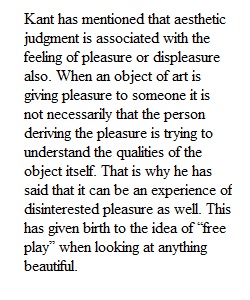


Q Week 5 Discussion 1 Resources Read/review the following resources for this activity: • Textbook: Cahn and Meskin, p. 131-140, 141-142 Introduction Kant makes the claim that true aesthetic appreciation is a result of experiencing a sense of disinterested pleasure when we encounter something beautiful and that this experience can be directly attributed to what he calls “free play.” The notion of free play further contributes to Kant’s belief that there CAN be a universal judgment regarding an object’s aesthetic value. Initial Post Instructions Describe a time in your life (recent or distant past) when you approached some form of art and believe you might have experienced this idea of free play. In other words, you felt a sense of aesthetic pleasure in the presence of some object and now recognize that your pleasure was disassociated from any unique personal connections. (Those versed in literary criticism would see such associations to personal events as being analogous to reader-response theory. To elaborate, the free play experience is the OPPOSITE of a reader-response interpretation.) Consider, in retrospect, how your experience might meet the criteria for having been “free play.” Provide evidence to support your choice. Secondary Post Instructions Respond to at least one peer and provide a substantive response to his/her postings. Was there consensus/disagreement? Did you gain any new learning? How might you persuade a peer who disagrees with your position to advocate a new point of view? ________________________________________ Writing Requirements • In addition to one initial post, respond to at least one peer • Initial Post Length: minimum of 300 words • Secondary Post Length: minimum of 300 words per post • Use MLA format for in-text citations and list of references. ________________________________________ Grading and Assessment Meeting the minimum number of postings does not guarantee an A; you must present an in-depth discussion of high quality, integrate sources to support your assertions, and refer to peers’ comments in your secondary posts to build on concepts. Course Learning Outcome(s): 1, 2, 3, 4 1. Defend the value and contribution of aesthetic experiences in human life. 2. Demonstrate an appreciation of art in its different forms. 3. Develop a fluency in fundamental aesthetic concept, theories, and ideas. 4. Synthesize theoretical explanations of aesthetic experience by creating a personal definition and evaluation of art. Due Date for Initial Post: By midnight on Wednesday Due Date for Response Post: By midnight on Sunday
View Related Questions